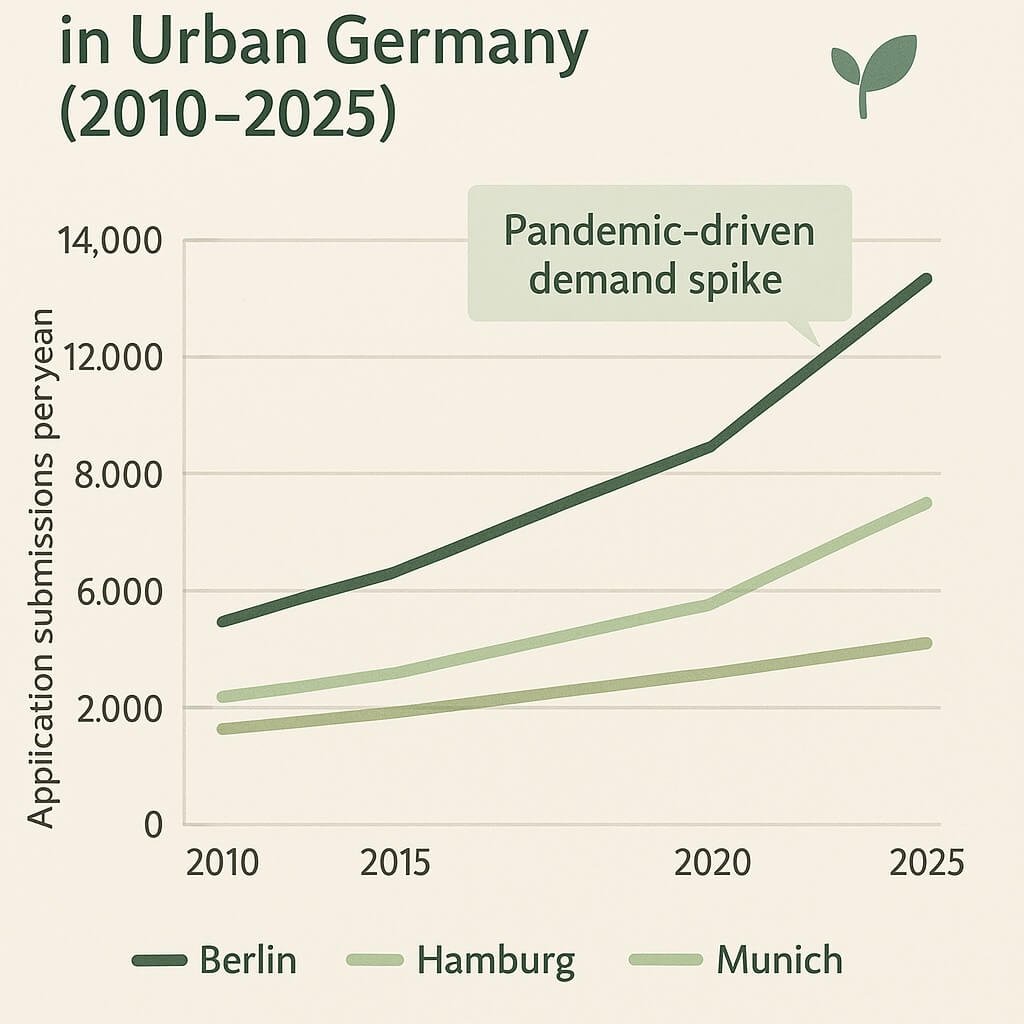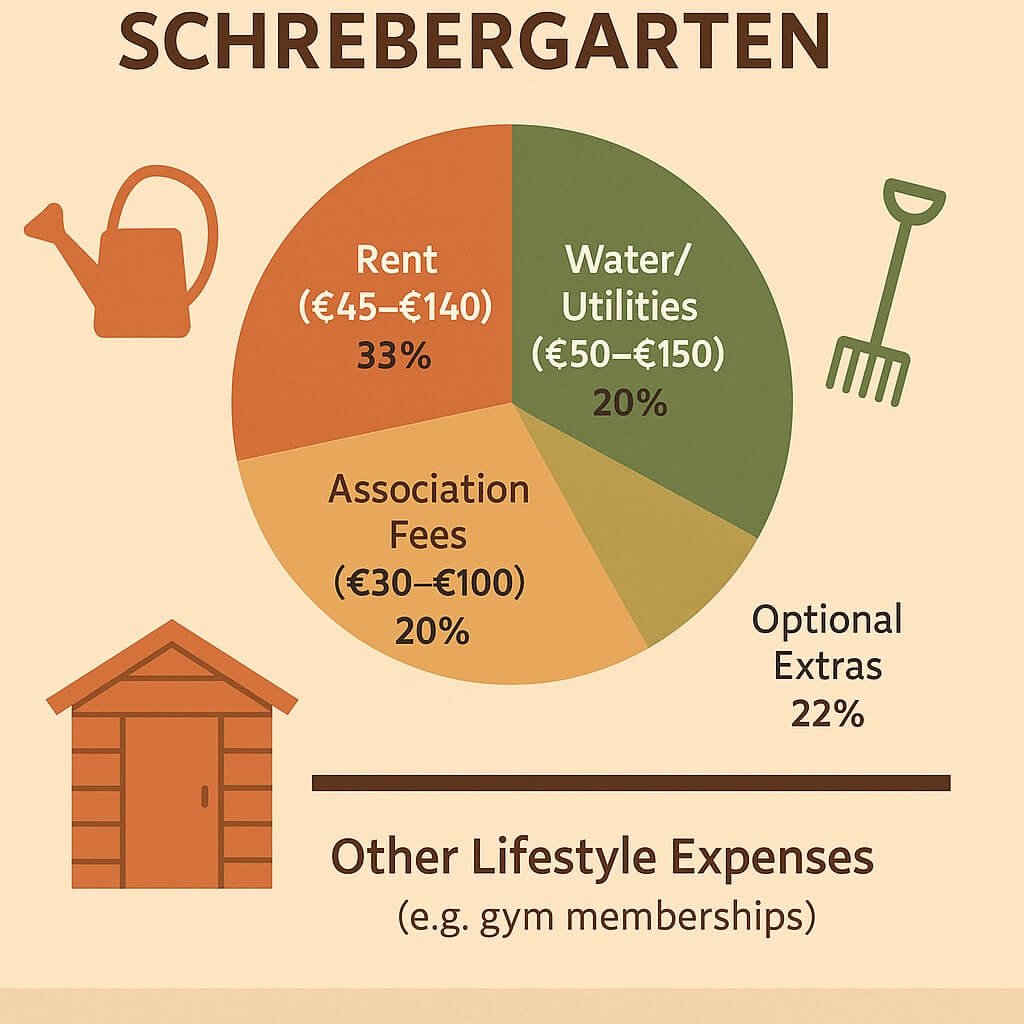For under €500 a year, you can enjoy a Gardening Allotments in Germany, also known as a Schrebergarten. These unique gardens offer a perfect mix of city life and the beauty of nature. Welcome to the wonderful world of Schrebergarten, where you can plant, grow, and relax in your own little green space!
What Are Schrebergarten and Kleingarten?
Schrebergarten and Kleingarten, two terms often used interchangeably, refer to small rented garden plots that provide urban dwellers a slice of nature. In Germany, these allotments usually include a patch of land for cultivating fruits and vegetables alongside a modest garden house or shed.
These garden areas are more than just places to grow plants. They are peaceful spots where families and individuals can relax, escape the busy city, and enjoy nature. These gardens provide fresh fruits and vegetables and serve as a calm escape from urban life.

A Glimpse into Their History
These gardens started in the 19th century to provide fresh air and healthy food for children from working-class families. They became important during the industrial era and during both World Wars, when food shortages made it vital for people to grow their own food.
Named after Dr. Moritz Schreber, a proponent of outdoor recreation for youth, these allotments gradually transitioned from a necessity into a cherished hobby for people from all walks of life. Today, they symbolise community, resilience, and a connection to nature in urban environments.
Current State and Statistics: How Many Gardens Are There?
Germany has nearly 890,000 Schrebergärten, covering around 44,000 hectares, according to the Federal Association of German Garden Friends (BDG). About 5 million people actively use these gardens, showing their continued popularity.

Is the Trend Increasing or Decreasing?
Interest in Schrebergärten has grown recently, especially among younger people and families. This shift is fueled by rising enthusiasm for sustainable living, homegrown food, and outdoor leisure. Demand is so high in urban areas like Berlin that waiting lists can stretch to over 12,000 names.
How to Get a Schrebergarten
If you want to rent a Schrebergarten plot, your first step is to join a local garden association—what’s known as a Kleingartenverein. These associations handle everything from plot allocation to upkeep standards. Once you register, they’ll put you on a list, and as soon as a plot becomes available, you’ll get your turn. It’s a straightforward process, but it helps to get in touch with them early on so you know what to expect.
Navigating Waiting Lists
The waiting time for a Schrebergarten depends significantly on where you live. In smaller towns and rural areas, plots can open up fairly quickly, but cities like Berlin or Munich can have long waiting lists. Don’t lose hope, though! You might find opportunities by checking online platforms like eBay Kleinanzeigen or contacting several associations. Being flexible and persistent often helps you secure a plot sooner.
Germany Gardening Allotments and Rent Prices

Rent for Schrebergärten is surprisingly affordable, especially considering the space you’re getting. On average, the rent is about 18 cents per square meter per year. In some high-demand cities like Berlin, it can climb to 35 cents per square meter. Most plots fall between 250 and 400 square meters, so your yearly rent usually ends in the €45 to €140 range. It’s a small price for a personal patch of greenery.
Additional Expenses
Of course, rent isn’t the only cost you’ll face. Many associations charge membership fees; you’ll likely need insurance to cover liabilities or damages. Then, there’s the cost of water for your plants, waste collection, and possibly a few upkeep expenses if your plot needs repairs or improvements. You’re looking at around €250 to €500 per year. It’s still a great deal for your little garden oasis.
Rules and Regulations: National Guidelines (Bundeskleingartengesetz)
In Germany, Schrebergärten are governed by a Federal Allotment Garden Law called the Bundeskleingartengesetz. According to these national guidelines, at least one-third of the plot must be used to grow fruits and vegetables—this keeps the garden’s original purpose of providing fresh food.
Additionally, while you’re allowed to build your garden hut, it’s strictly for storage and leisure. These huts can’t exceed 24 square meters, and living in them permanently is not allowed. It’s about balancing leisure gardening and maintaining a productive, community-oriented space.
Local Association Rules
In addition to national laws, each community garden association has its own specific rules. These local rules can cover various topics, such as how tall hedges can grow, quiet times when noise should be kept to a minimum, or shared responsibilities like helping to keep paths and common areas tidy. Some groups may have very relaxed rules, while others may be more strict. Before you join, it’s a good idea to check out the association’s rulebook to understand what is expected of you clearly.
Benefits and Advantages
A Schrebergarten is more than just a spot for planting vegetables or flowers. It can boost your quality of life! It helps you eat healthier, gives you a peaceful place to unwind, brings people together in the community, and is suitable for the environment, too.

Growing Your Food
One of the greatest joys of having a small garden is growing your own fruits and vegetables. When you grow your own food, you rely less on store-bought items, avoid many chemicals, and enjoy fresher, more delicious flavors. It’s a fulfilling way to eat healthier, cut down on trips to the grocery store, and savor the simple joys of bringing food right from the garden to your table.
A Space for Relaxation
In the middle of a busy city, a Schrebergarten becomes your retreat. It’s a place to unwind, read a book, or spend a quiet afternoon away from the noise. You can also host small gatherings or enjoy a family picnic; it’s your little oasis in the middle of the urban rush.
Building Community
Schrebergärten, or community gardens, are more than just places to grow plants; they also bring people together. These shared gardens provide a space for neighbors to connect, whether for a barbecue, working on a garden project, or just sharing gardening advice. Through these activities, friendships are formed, and a strong sense of community develops over time.
Environmental Impact
Having a Schrebergarten isn’t only good for you—it’s good for the environment, too. Allotments help increase urban biodiversity by providing bird, bee, and other wildlife habitats. Many gardeners also focus on sustainable practices, like composting or organic growing methods, which contribute to a healthier planet.
Challenges and Criticisms: Accessibility Issues
One of the biggest challenges with Schrebergärten is how hard it can be to get one. In high-demand areas, waiting lists can be years long, making it feel like these green spaces are reserved for just a few. This limited availability can frustrate anyone hoping to join the Schrebergarten community.
Affordability Concerns
Although Schrebergärten are generally affordable, the costs can increase, especially in expensive cities. Beyond rent, there are association fees, insurance, and maintenance expenses. For those with tighter budgets, these cumulative costs may put a Schrebergarten out of reach.
Land Use Controversy
Another sticking point is space. Schrebergärten take up large chunks of prime city land. As Germany’s cities grow, there’s mounting pressure to build more housing, especially affordable units. Critics argue that some of this land might be better used for new development. On the other hand, defenders point out that green spaces offer mental health benefits and community ties that concrete can’t replace. The debate is far from settled.
My Story for Schrebergarten
Two summers ago, my friend Aaga landed a Schrebergarten just outside Hamburg. I still remember the text she sent: “We got it! Plot **, a real jungle, but it’s ours!”
They were beaming with pride. “It’s our first harvest,” Aaga said. “We had no idea what we were doing. But somehow, it worked.”
Meanwhile, I’m still waiting.
It’s been nearly two years since I added my name to the list in Hamburg. Every spring, I check in with the association. “Still no updates,” they always say politely. The demand here is intense, and spots rarely open up.
Until my name is called, I visit her plot when I can. I water the herbs, pull a few weeds, and soak in the peace. It’s not my garden yet, but it still feels like a little piece of something hopeful.
Conclusion
Key Takeaways
Schrebergärten are more than garden plots. They’re a window into Germany’s cultural values — community, balance, and respect for nature. Born out of social need, these gardens have evolved into a modern solution for urban stress and environmental awareness.
They offer practical benefits (like fresh produce), personal joy, and shared connection — all on a tiny patch of land.
Call to Action
If you live in Germany and haven’t explored the world of Schrebergärten, now’s the time. Visit a local Kleingartenverein. Add your name to a waitlist. Or simply walk by one on a sunny afternoon and take in the buzzing bees, hand-painted gnome signs, and scent of grilled vegetables in the air.
Even if you don’t rent one — these little gardens are worth appreciating. They remind us that nature, community, and well-being can thrive, even in the middle of a city.

